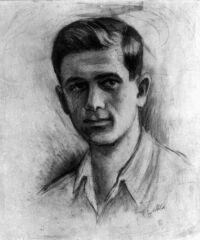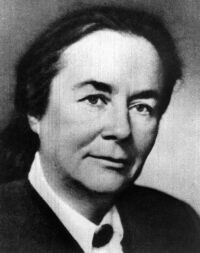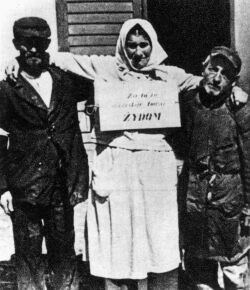





Mordechaj Anielewicz, (1919 - 1943), commandant of the Jewish Combat Organization (ŻOB), commander-in-chief of th Warsaw Ghetto Uprising.
Jan Kozielewski-Karski (1914-2000), historian, courier of the Polish Underground State. Several times he informed western governments about the situation of the Jews under the German occupation. In 1942 he reported to the governments of the Allies on the Holocaust, and a year later he did it personally to the President of the United States.
Jewish insurgents caught after leaving their hidings, May 1943. The captives were escorted to the Umschlagplatz and then transported to extermination camps or shot on the spot.
Leaflet "Protest" distributed in August 1942, that initiated the foundation of the Council to Aid the Jews "Żegota" (formerly a Committee for Aid to Jews), operating under the umbrella of the Government Delegate's Office at Home of the Polish Government in Exile.
OD-men escorting a child caught smuggling food to Warsaw ghetto.
|

Zofia Kossak-Szczucka (1890 - 1968), writer, author of the proclamation "Protest", prisoner of KL Auschwitz and Pawiak.
Szmul Zygielbojm (1895 - 1943), Bund activist, member of the Warsaw City Council, member of the National Council of the Polish Government in Exile. He committed suicide in protest against indifference of the Allied governments towards the Holocaust.
One of the last columns of the displaced Jews leaving the burning ghetto, May 1943. Gen. Jürgen Stropp could report: "The former Jewish district ceased to exist [...] The total of the captive Jews and those, whose death could be ascertained comes to 56065".
Jewish partisan detachment, Lublin's district 1943. Before long those few entirely Jewish detachments got destroyed. The Jews fought also in the detachments of various Polish military organizations and Soviet stay behind forces operating in the territory of Poland.
Information Bulletin of the High Command of the Home Army, 1943.
|

Female inhabitant of Grybów (near Nowy Sącz) being stigmatized for the aid given to the Jews. The inscription on the plate says: "For selling goods to the JEWS". H. Frank's regulations of 15th October 1941, required every Jew caught outside the ghetto as well as the people helping them (e.g. hiding them, selling them food or even giving them a glass of water) being condemned to death.
In spite of the alarming reports about ongoing total extermination of the Jews, governments of the free world did not take any decisive action that could stop the Holocaust. The Jews were left forlorn without any hope for help from the Allies. They were being murdered and hunted on the "Aryan" side of the ghetto wall. Only very few of them were prepared for the armed resistance. They were fighting for the right to the dignified death. Poorly armed members of the Jewish Combat Organization (ŻOB) fought the Germans liquidating ghettos, e.g. in Warsaw and Białystok. Neither Polish armed underground nor the civilian organization "Żegota" couldn't give them sufficient aid. The Warsaw Ghetto Uprising became a symbol of heroic fight of the Jewish nation doomed to death.
Warsaw ghetto burning during the uprising, May 1943. The Germans burned methodically street after street, building after building. SS-men were throwing inside grenades and smoke pots; people were leaving their hidings then, sometimes jumping out of the windows.
|

